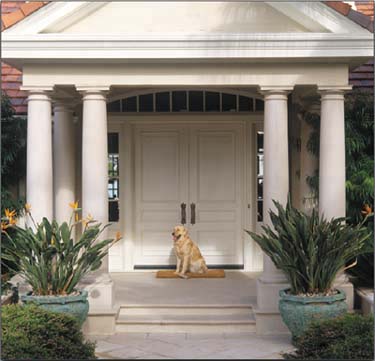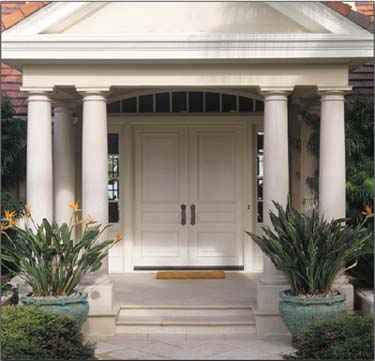| Problem: Unwanted object in an image. 
Solution: Use the Erase, Copy, and Paste commands. 
| You need a photo of a front porch for a brochure and you found a great one, except for one problem: Man's best friend decided to pose for the picture as well. You can cry "Here, boy!" all you want, but that's not going to solve the dilemma. The photo was taken last summer and can't be reshot. What to do? It's erase, copy, paste, and tone to the rescue. |
Removing an object Before we begin removing anything, we should create a duplicate layer to work on and zoom in on the object we wish to remove. Let's also disable the visibility of the Background layer by clicking on the Indicates Layer Visibility icon  in the Layers palette so we can see what we've erased in the Background Copy layer as we go. Now you're ready to start erasing. in the Layers palette so we can see what we've erased in the Background Copy layer as we go. Now you're ready to start erasing. 1. | Choose the Eraser tool  from the Toolbox and set your options on the tool options bar. from the Toolbox and set your options on the tool options bar.
| 2. | Choose Soft Round 17 Pixels from the Brush Preset Picker. Select Brush from the Mode dropdown list to give a soft erasing edge.
| 3. | Keep the Opacity set at 100%, and leave the Erase To History button deselected because we aren't erasing to a saved state or snapshot of the image.
| 4. | Move the mouse pointer to the center of the object that you wish to erase, and while holding down the mouse button, begin to erase. It's best to start in the center of the object and move out close to the edges. Zoom in for an even closer view when you're finished.
| 5. | Choose Soft Round 5 Pixels from the Brush Preset Picker so you can erase the fine details along the edges of the object.
|
Filling in empty image areas using Copy and Paste First, let's study what's missing and decide how we're going to replace it. In our example, image areas to the left and right of the door look compatible in color and textureas well as areas to the left and right of the kickboard, the fiber doormat, and the slate tiles. Selecting image areas to copy 1. | Drag out a few guides to help select an area to copy from and paste to by moving your mouse pointer to first a vertical and then a horizontal ruler, clicking on it, and while holding down your mouse button, dragging horizontal and vertical guides into position.
| 2. | Choose View  Snap. Snap.
| 3. | Choose the Rectangular Marquee tool  from the Toolbox, position your mouse pointer on the upper-left corner of the rectangle, drag it across and down to the lower-right corner, and release your mouse button. With the Rectangular Marquee tool still selected, move your mouse pointer to the center of the rectangular selection border, click on the border, and while holding down your mouse button, drag the border to the left of the left vertical guide. from the Toolbox, position your mouse pointer on the upper-left corner of the rectangle, drag it across and down to the lower-right corner, and release your mouse button. With the Rectangular Marquee tool still selected, move your mouse pointer to the center of the rectangular selection border, click on the border, and while holding down your mouse button, drag the border to the left of the left vertical guide.
|
Copying and pasting image areas 1. | Press [Ctrl]C ( C on the Mac) to copy and then [Ctrl]V ( C on the Mac) to copy and then [Ctrl]V ( V on the Mac) to paste it. V on the Mac) to paste it.
| 2. | Name the new pasted layer by selecting Layer 1 in the Layers palette.
| 3. | Choose the Move tool  from Toolbox and move your mouse pointer to the center of the pasted image. Click on it and while holding down your mouse button, drag the image to inside the guides. from Toolbox and move your mouse pointer to the center of the pasted image. Click on it and while holding down your mouse button, drag the image to inside the guides.
|
Adjusting the pasted image to its surroundings To help evaluate and adjust the pasted image, or patch, as it's sometimes known (and certainly easier to say), let's move it down a layer so it's filling the erased area rather than covering it. 1. | Select the pasted image layer in the Layers palette, and while holding down the mouse button, move the layer down one position below the Background Copy layer, then release.
| 2. | Erase a little more of the edge, using the Eraser tool, in the Background Copy layer to soften the transition between the door and the patch, using the Soft Round 21 Pixels brush.
| 3. | Darken the patch, if needed, by choosing Image  Adjustments Adjustments  Brightness/Contrast. The Brightness/Contrast dialog box appears. Move the Brightness slider to the left until the patch disappears into its surroundings. Brightness/Contrast. The Brightness/Contrast dialog box appears. Move the Brightness slider to the left until the patch disappears into its surroundings.
| 4. | Selectively darken any areas as needed, by using the Burn tool. To do so, choose the Burn tool  from the Toolbox, and on the tool options bar, select the Soft Round 45 Pixels brush, set the Range for Highlights, and an Exposure of 1%. Move your mouse pointer to the area you wish to adjust and begin burning gradually. If an area is a little dark, gradually lighten it with the Dodge tool. from the Toolbox, and on the tool options bar, select the Soft Round 45 Pixels brush, set the Range for Highlights, and an Exposure of 1%. Move your mouse pointer to the area you wish to adjust and begin burning gradually. If an area is a little dark, gradually lighten it with the Dodge tool.
|
|


 Snap.
Snap. Brightness/Contrast. The Brightness/Contrast dialog box appears. Move the Brightness slider to the left until the patch disappears into its surroundings.
Brightness/Contrast. The Brightness/Contrast dialog box appears. Move the Brightness slider to the left until the patch disappears into its surroundings.